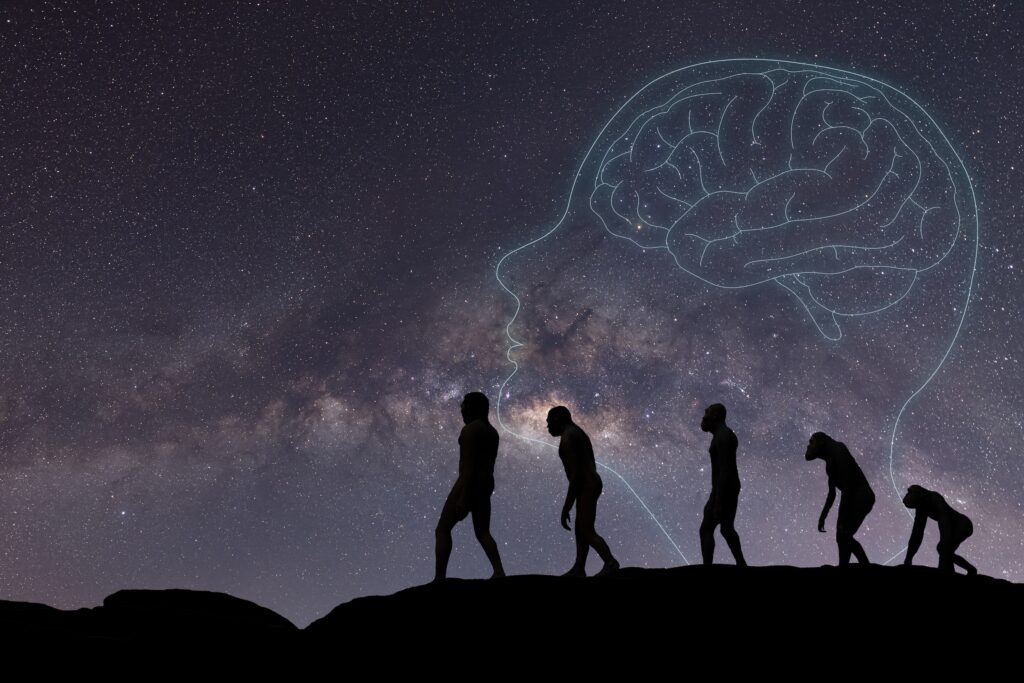Falling for naive common-sense: Russell and physical realism (The Return of Metaphysics)
Reading | Philosophy
![]() Prof. Fraser MacBride, PhD | 2022-05-15
Prof. Fraser MacBride, PhD | 2022-05-15

This essay recounts the story of our falling for naive physical realism—the notion that we can become directly acquainted with non-mental entities, which are supposed to have standalone existence—in the early 20th century, and how modern thought is now bringing us back to the more mature German Idealism that prevailed in the West during the early 19th century. This is the fourth instalment of our series, The Return of Metaphysics, produced in collaboration with the Institute of Art and Ideas (IAI). It was first published by the IAI on May 9, 2022.
In the late 1890s the Cambridge philosophers G.E. Moore and Bertrand Russell made a remarkable and creative leap forward: their ‘discovery’, they declared, was of the principles underlying what they called their ‘New Philosophy.’ According to this philosophy, reality consists of a mind-independent plurality of separate, independently existing entities. They are entities that, when we perceive them, are given to us immediately or directly, so without relying upon our having any mediating ideas or internal representations of them, hence given to us without any conceptual trappings of our mental making.
Moore and Russell called their philosophy ‘new’ because they believed its discovery marked a decisive break in history; they envisaged their philosophy would sweep away all of its predecessors. Even though other philosophical traditions endured and indeed flourished later, their youthful confidence was far from being entirely misplaced. Their New Philosophy was destined to become one of the contributing streams—one of the most significant—that fed into what was to become that great intellectual river system, analytic philosophy. Nonetheless, a key idea from the Hegelian philosophy they were revolting against would continue to pose a challenge to their realist shift.
The resurgence and death of Hegelian philosophy?
To most bystanders watching at the end of the nineteenth century, it would hardly have seemed likely that the New Philosophy would turn into analytic philosophy, and analytic philosophy then become the dominant tradition in the United Kingdom. During the late nineteenth century, Hegelian idealists had become the dominating force in British philosophy, although it would still be an exaggeration to say that theirs was the only voice to be heard. But the British Hegelians had the ascendency and they were inspired by some of the most general features of Hegel’s worldview—even if they didn’t always embrace the specific details of Hegel’s philosophy or his dialectical method, whereby intellectual advance is to be achieved by overcoming the contradiction of thesis and antithesis to achieve a higher synthesis. What especially captivated the British idealists was Hegel’s belief that separateness is ultimately an illusion. The apparent separateness of things—their plurality—was, for Hegel, an illusion, because he held that what is ultimately real and intelligible is only the whole of reality; apparently separate things only have reality to some degree, depending upon the degree to which they contribute to the intelligibility of the whole. Hegel called the whole of reality ‘the Absolute’ and he conceived of the Absolute as spiritual [Editor’s note: it can be argued that ‘spiritual’ is a mistranslation of Hegel’s original ‘Geist,’ which also means ‘mind,’ in which case Hegel’s Absolute is mental, not spiritual.] Moore and Russell held just the opposite of this. According to the New Philosophy, separate things are perfectly intelligible independently of one another, or anything else, whilst the whole of reality isn’t spiritual.
What many of the British Hegelians found inspiring about Hegel’s worldview, at least since the publication in 1865 of J.H. Stirling’s The Secret of Hegel, was the promise it held out of a metaphysical backing for religion, religion having hitherto been threatened by the advance of materialism and the reception of Darwin’s theory of evolution. The Scottish philosopher Edward Caird (1835-1908), who held a Chair of Philosophy in Glasgow before becoming the Master of Balliol College in Oxford, was a leading and influential advocate of this Hegel-inspired apologia for religion. In his Hegel, published in 1883, Caird maintained that religion and materialistic science aren’t really in conflict at all because neither make sense except when understood as a partial fragment of a higher, integrated unity.
The resurgence of interest in Hegel to be found in Britain—and, as it happens, around the same time, in the United States too—also ranks as a twist of philosophical fate that could hardly have been expected by many bystanders. That’s because Hegel’s philosophy had been largely buried and defunct in Germany by mid-century. The peculiarity of the historical situation wasn’t lost upon the American pragmatist William James (1842-1910). He wrote,
We are just now witnessing, a singular phenomenon in British and American philosophy. Hegelism, so entirely defunct on its native soil that I believe but a single young disciple of the school is to be counted among the privat-docents and younger professors of Germany, and whose older champions are all passing off the stage, has found among us so zealous and able a set of propagandists that to-day it may really be reckoned one of the most potent influences of the time in the higher walks of thought.
What explained the decline of Hegel’s influence in Germany was a ‘back to Kant’ movement, a ‘neo-Kantianism’ that eschewed speculative metaphysics, such as Hegel had inspired, in favour of a respect for the natural sciences. The Marburg School of Neo-Kantians, in particular, had an especial interest in understanding, methodologically speaking, how the natural sciences functioned. It was a movement destined to be one amongst other sources of another of the most significant streams feeding into the river system of analytic philosophy: namely, the logical empiricism of the Vienna Circle.
The realist challenge of science and common sense
The fact is that Moore and Russell, in the late 1890s, were more aligned with the prevailing currents of European thought than any of the British Hegelians. Nevertheless, they still considered the system of one British Hegelian, the Oxford philosopher F.H. Bradley (1846-1924), an important foil for their own philosophy. But why did they consider it worth engaging with the views of any British Hegelian? The answer was that Bradley stuck out from the rest. Like many British Hegelians, Bradley had been an admirer of Hegel without adhering to the details of Hegel’s philosophy. But Bradley was led by his arguments to a conclusion that went further from Hegel than other Hegelians were prepared to envisage. For this reason, Bradley came under fire just as much from them as from his other adversaries. Caird had argued in more or less general and speculative terms for a higher synthesis of science and religion to resolve the widely acknowledged clash between them. By contrast, Bradley argued with a forthrightness and dialectical acumen that emulated Parmenides and Zeno, albeit expressed with Victorian curlicues. Bradley aimed for the destructive conclusion that discursive thought per se is ultimately unintelligible, inevitably driven to its own ‘suicide’—and that included common-sense, scientific and religious thought. Since Moore and Russell held discursive thought to be the very vehicle of intelligibility, but found Bradley’s arguments demanding and difficult to dismiss, the philosophical stakes could not have been higher for them. They had no choice, intellectually speaking, but to engage with Bradley.
To think discursively is to reflect upon the connections between separate things, their interrelatedness. That means thinking, for example, about the resemblance of one thing to another, or reflecting upon the distance between them, or registering the fact that what happens to one is before what happens to the other. Bradley’s point was that the idea of one thing or event connected to another, whether in space or time or by relations of resemblance, makes no sense.
One of the arguments upon which he placed the greatest weight is now called ‘Bradley’s Regress.’ It takes the form of a dilemma. Suppose we take the connection between two things to be ‘something itself,’ so distinct from both of them. This means the connection is a third thing. But we cannot understand their connection this way. By construing their connection as a third thing that, so to speak, sits alongside them, we have only added to our labours because now we have to explain how these three things are connected. It won’t help to say that the connection with them is a fourth thing because their connection will be a fifth thing, and so on, ad nauseum. Alternatively, if the connection between two things isn’t ‘something itself,’ it is mysterious how the two are connected at all. Bradley summarized, “If you take the connection as a solid thing, you have got to show, and you cannot show, how the other solids are joined to it. And, if you take it as a kind of medium or unsubstantial atmosphere, it is a connection no longer.” Since discursive thought presupposes the intelligibility of connections and there’s no making sense of connections, Bradley concluded that discursive thought cannot be ultimately intelligible. This wasn’t the only argument Bradley gave for this conclusion, but it was the argument he prized the most.
The Archimedean point from which Russell chose to mount his defence of discursive thought against Bradley’s onslaught was the outlook of contemporary scientific culture. Russell’s strategic judgment was that “there is more likelihood of error” in Bradley’s argument “than in so patent a fact as the interrelatedness of the things in the world.” Russell felt entitled to this judgement of the relative likelihood of error in Bradley’s argument because, as a matter of fact, science presupposes that there are interrelated things. This presupposition has survived the test of time, paying dividends in terms of the scientific developments that depend upon it, but also the technological applications of science. Consider, for example, the kinetic theory of gases, which presupposes that a gas consists of a large number of particles in rapid motion, which are constantly colliding: what that means is a plurality of separate but interrelated things. Russell conceded that, if we were ancient Greeks, ignorant of subsequent scientific achievements, then we might follow Bradley’s argument where it leads. But we cannot wish away what we know now, as members of a scientific culture that has seen extravagant philosophical systems and philosophers’ iconoclastic arguments continually fall by the wayside whilst scientific knowledge, which presupposes the interrelatedness of separate things, has inexorably accumulated. Knowing what we know now, we cannot follow Bradley’s argument where it leads.
Moore shared Russell’s strategic judgement of the relative likelihood of error having crept into Bradley’s argument, but Moore’s Archimedean point was a different one. He had a common-sense outlook, a worldview whose successful track record outstrips even that of science—a track record, running back millennia rather than centuries, of enabling Homo sapiens to successfully navigate their environment. For Moore, the common-sense view is that there are many material objects, both animate and inanimate, which occupy space, and there are many events to which material objects contribute, which occur in time, and that besides having bodies, we have minds, and we know all this to be true because of our appreciation of concrete cases. Bradley had argued that neither space nor time can be real because space and time presuppose that there are spatial and temporal relations holding between separate things and separate events, the kind of interrelatedness that Bradley held to be unintelligible. Moore replied that his pen was sitting right next to his inkwell and he had definitely gone for a stroll after lunch. Moore put it to his audiences that we are each of us far more certain of such concrete truths than we are certain of the cogency of Bradley’s reasoning. So common sense, never mind the scientific outlook, tells us we’re not in a position to repudiate the reality of interrelatedness.
Russell’s ‘knowledge by acquaintance,’ the myth of Given, and the return of Hegel
Did this mean that the New Philosophy had won? Bradley didn’t think so, because he was prepared to deny the intelligibility of science and our common-sense outlook. But whilst few British Hegelians were prepared to follow Bradley in this regard, they had other criticisms to make of the New Philosophy. Russell argued that our having knowledge of the external world relies upon our having ‘acquaintance’ with objects that are immediately given to us, where to be acquainted with an object means being primitively aware of it without knowing anything else about it—so without the distorting filters of our conceptual scheme. This was akin to the kind of cognitive set-up that Hegel had called ‘sense-certainty’ and subjected to searching criticism. Hegel’s basic point was that we cannot claim to have cognitively targeted some particular thing, and kept track of it, unless we are able to say what distinguishing features it has. But this requires us to have more than knowledge of the pure particular.
G.F. Stout (1860-1944) was one British philosopher who was influenced by Hegel, if not a card-carrying Hegelian. Stout had supervised Moore and Russell as undergraduates in Cambridge during the 1890s, but spent most of his career at the University of St. Andrews. It was integral to Stout’s philosophy that we cannot have immediate acquaintance with an object without knowing any truths about it. So Stout’s criticism of Russell, that “mere existential presence is not knowledge at all,” echoed Hegel’s critique of sense-certainty. Mere existential presence cannot provide the basis for cognitively detaching an object from its environment, because, Stout wrote, “If we inquire what in mere acquaintance we are acquainted with, mere acquaintance itself, being blind and dumb, can supply no answer.” In this respect Stout anticipated later developments within analytic philosophy, specifically Wilfred Sellar’s (1912-89) famous critique of ‘the Myth of the Given.’ So even though Moore and Russell’s common-sense and scientific outlooks carried the day, whilst Hegelianism became as defunct in the United Kingdom as it already had in Germany, recognizably Hegelian ideas continued to pose a challenge to Russell’s and Moore’s realism.

Essentia Foundation communicates, in an accessible but rigorous manner, the latest results in science and philosophy that point to the mental nature of reality. We are committed to strict, academic-level curation of the material we publish.
Recently published
Reading
Essays
Seeing
Videos
Let us build the future of our culture together
Essentia Foundation is a registered non-profit committed to making its content as accessible as possible. Therefore, we depend on contributions from people like you to continue to do our work. There are many ways to contribute.















